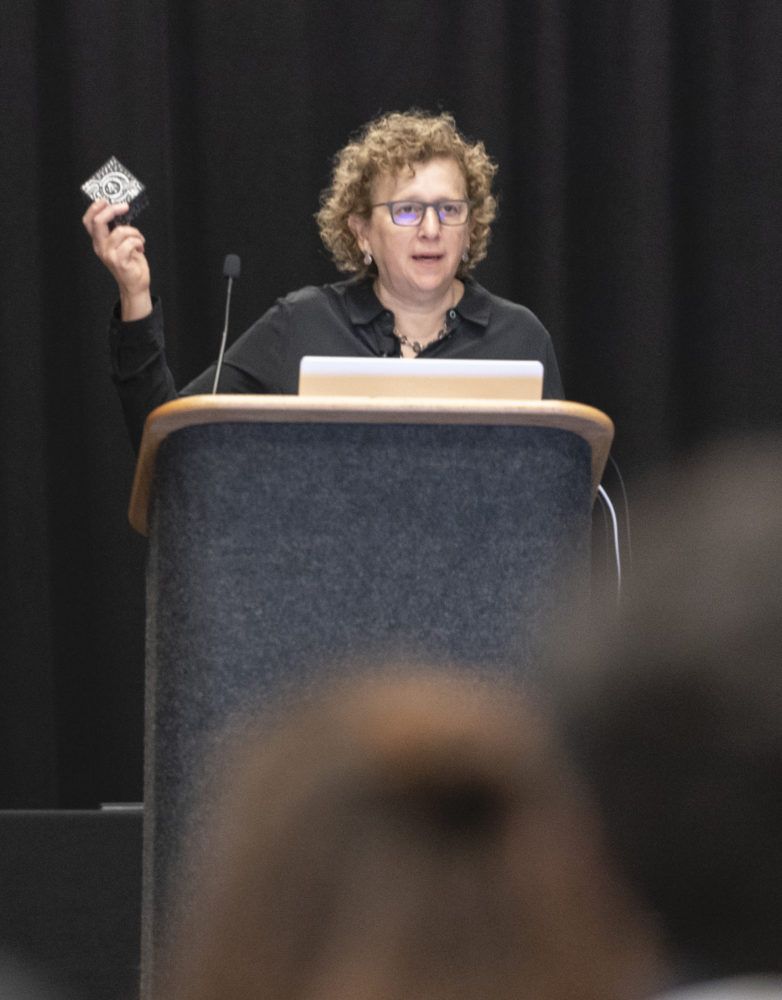
Astronomer Alyssa Goodman presents tenth Patrusky Lecture at ScienceWriters2022
2022 Patrusky Lecturer Alyssa Goodman displays an augmented reality target cube, one of many tools astronomers and other scientists are using to visualize and explore data sets that are increasingly large and high-dimensional. (Photo by Ann-Margaret Hedges.)
Harvard astronomer Alyssa A. Goodman presented the tenth Patrusky Lecture on October 23, 2022, as part of New Horizons in Science, CASW’s annual briefing on emerging research and issues in science.
Goodman (@AlyssaAGoodman) addressed science writers attending ScienceWriters2022 in Memphis, Tenn. The conference, jointly organized by CASW and the National Association of Science Writers and hosted this year by St. Jude Children’s Research Hospital, incorporatesd the CASW science sessions and NASW’s professional development programming.

In her talk, “The New Universe,” Goodman looked forward to the potentially surprising discoveries that will emerge as astrophysics is reorganized around remarkable new methods that harness the power of visualization, computer simulation, large-scale collaboration, and powerful instruments such as the new James Webb Space Telescope and the European Space Agency’s Gaia mapping project. In January, for example, Goodman was part of a collaboration that used Gaia data in concert with powerful new data science and visualization techniques to discover that every star-forming gas cloud in the Sun’s neighborhood of the Milky Way lies on the surface of a giant evacuated cavity called the Local Bubble.
“This year, as we’re awed and inspired by images from the newest space telescope, CASW is thrilled to have as our Patrusky Lecturer a scientist who will show us how new telescopes and technologies may reshape our understanding of the universe,” said CASW President Robin Lloyd in announcing Goodman’s selection as Patrusky Lecturer. “Alyssa Goodman has created remarkable visualization tools that help scientists across several fields wrestle with complex, multidimensional data sets, and her work with the WorldWide Telescope has made astronomical knowledge accessible to audiences around the world. Science writers can look forward to an exciting trip through space and time and a glimpse of the future of science.”
Goodman is the Robert Wheeler Willson Professor of Applied Astronomy at Harvard University and a research associate of the Smithsonian Institution. Her research and teaching interests span astronomy, data visualization, and online systems for research and education.
Goodman received her undergraduate degree in physics from MIT in 1984 and a PhD in physics from Harvard in 1989. She was awarded the Newton Lacy Pierce Prize from the American Astronomical Society in 1997, became full professor at Harvard in 1999, was named a Fellow of the American Association for the Advancement of Science in 2009, and was chosen as Scientist of the Year by the Harvard Foundation in 2015. She has served as chair of the Astronomy Section of the American Association for the Advancement of Science and on the National Academy’s Board on Research Data and Information, as well as several other committees and boards charting the future of astronomy and data science, nationally and internationally.
Goodman’s personal research currently focuses primarily on new ways to visualize and analyze the tremendous data volumes created by large and/or diverse astronomical surveys, and on improving our understanding of the structure of the Milky Way Galaxy. She is principal investigator for the NSF and NASA-sponsored glue software effort, which creates new tools for high-dimensional data visualization across science and education. She also works closely with colleagues at the American Astronomical Society and Harvard to expand the use of the WorldWide Telescope Universe Information System in both research and education. Goodman leads the Prediction project at Harvard University, which traces the roots of modern computer simulation, as prediction, through history, all the way back to the sheep entrail divination practiced in Mesopotamia.
The Patrusky Lectures were launched by CASW in 2013 to honor Ben Patrusky, executive director of CASW for 25 years and director of the New Horizons in Science program for 30 years.